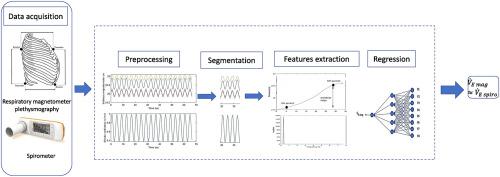Computers in Biology and Medicine ( IF 7.0 ) Pub Date : 2021-01-02 , DOI: 10.1016/j.compbiomed.2020.104189 Aya Houssein 1 , Di Ge 2 , Steven Gastinger 3 , Remy Dumond 4 , Jacques Prioux 4

|
Purpose
The purpose of this study was to evaluate the accuracy of minute ventilation () estimation using a novel method based on a non-linear algorithm coupled with cycle-based features. The experiment protocol was well adapted for remote health monitoring applications by exploiting data streams from respiratory magnetometer plethysmography (RMP) during different physical activity (PA) types. Methods Thirteen subjects with an age distribution of years performed thirteen PA ranging from sedentary to moderate intensity (walking at 4 and 6 km/h, running at 9 and 12 km/h, biking at 90 W and 110 W). In total, 3359 temporal segments of 10s were acquired using the Nomics RMP device while the iWorx spirometer was used for reference measurements. An artificial neural network (ANN) model based on respiration features was used to estimate and compared to the multiple linear regression (MLR) model. We also compared the subject-specific approach with the subject-independent approach. Results The ANN model using subject-specific approach achieved better accuracy for the estimation. The bias was between and l/min with the ANN model as compared to and l/min with the MLR model. Conclusion Our results demonstrated the pertinence of processing data streams from wearable RMP device to estimate the with sufficient accuracy for various PA types. Due to its low-complexity and real-time algorithm design, the current approach can be easily integrated into most remote health monitoring applications coupled with wearable sensors.
中文翻译:

磁力计体积描记法在远程健康监测中微小通风估计的新算法
目的
这项研究的目的是评估分钟通气的准确性()估算,并使用一种基于非线性算法并结合基于周期的特征的新颖方法。通过在不同的体育活动(PA)类型期间利用呼吸磁力计体积描记法(RMP)的数据流,该实验协议非常适合远程健康监测应用。方法13位年龄分布为年进行了13次PA,范围从久坐到中等强度(以4和6 km / h的速度行走,以9和12 km / h的速度行走,以90 W和110 W的速度骑行)。使用Nomics RMP设备总共采集了3359个10s的颞段,而iWorx肺活量计被用作参考测量。基于呼吸特征的人工神经网络(ANN)模型用于估算并与多元线性回归(MLR)模型进行比较。我们还比较了特定于主题的方法和独立于主题的方法。结果使用特定主题方法的ANN模型在估计。偏见介于 和 ANN模型的l / min与 和 MLR模型的升/分钟。结论我们的结果证明了处理可穿戴RMP设备中的数据流以评估设备的相关性。具有足够的精度以适应各种PA类型。由于其低复杂度和实时算法设计,当前的方法可以轻松地集成到大多数可穿戴传感器与远程健康监测应用程序中。











































 京公网安备 11010802027423号
京公网安备 11010802027423号